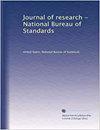The present status of the standards of thermal radiation maintained by the Bureau of Standards
引用次数: 12
Abstract
The basis of the lamp standards of radiation, established and maintained by the Bureau of Standards since 1913, is the black body using the Stefan-Boltzmann constant of total radiation <7= 5.70X10 watt/cm/deg. 4 In this paper the present status of the value of the constant of total radiation is reviewed, and it is concluded that, for the present, the basis of the lamp calibration remains unchanged. These carbon-filament lamp standards of thermal radiation maintained by the Bureau of Standards (S227) were intercompared after a lapse of 12 years and found in good agreement with the original standards which were established in 1913 by direct comparison with a black body. Two reproductions of these standards which, according to published reports, showed rapid deterioration in radiant flux, were recalibrated. No deterioration, to 2 parts in 840, could be measured in the radiation emitted by one of these lamps which had been in use 8 years. In the other lamp an increase in radiant flux, amounting to about 1 percent, was found. This was caused by a hot spot in the filament, probably resulting from usage or perhaps by injury in shipment. In a life test, a standard of radiation was operated for 245 hours before an increase in radiant flux became appreciable, and at the expiration of 300 hours this increase amounted to only 0.8 percent. One section is devoted to the technique of operation, and specific directions are given to insure high precision.国家标准局维护的热辐射标准的现状
自1913年以来,由标准局建立和维护的灯辐射标准的基础是黑体使用总辐射的斯特凡-玻尔兹曼常数<7= 5.70X10瓦/厘米/度。本文对总辐射常数的取值现状进行了综述,得出的结论是,就目前而言,灯具标定的基础没有改变。这些由标准局(S227)维护的碳丝灯热辐射标准在12年后进行了相互比较,通过与黑体直接比较,发现与1913年建立的原始标准非常一致。根据已发表的报告,这些标准的两个复制品显示辐射通量迅速恶化,因此重新进行了校准。这些灯已经使用了8年,其中一盏灯发出的辐射并没有退化到840的2倍。在另一盏灯中,发现辐射通量增加了约1%。这是由灯丝中的一个热点引起的,可能是由于使用或运输中受伤造成的。在寿命试验中,一个标准辐射运行245小时后,辐射通量才有明显的增加,300小时结束时,这一增加仅为0.8%。其中一节专门介绍了操作技术,并给出了具体的操作指导,以确保高精度。
本文章由计算机程序翻译,如有差异,请以英文原文为准。
求助全文
约1分钟内获得全文
求助全文

 求助内容:
求助内容: 应助结果提醒方式:
应助结果提醒方式:


